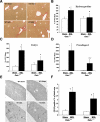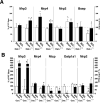Mouse organic solute transporter alpha deficiency enhances renal excretion of bile acids and attenuates cholestasis
- PMID: 19902485
- PMCID: PMC2819820
- DOI: 10.1002/hep.23265
Mouse organic solute transporter alpha deficiency enhances renal excretion of bile acids and attenuates cholestasis
Abstract
Organic solute transporter alpha-beta (Ostalpha-Ostbeta) is a heteromeric bile acid and sterol transporter that facilitates the enterohepatic and renal-hepatic circulation of bile acids. Hepatic expression of this basolateral membrane protein is increased in cholestasis, presumably to facilitate removal of toxic bile acids from the liver. In this study, we show that the cholestatic phenotype induced by common bile duct ligation (BDL) is reduced in mice genetically deficient in Ostalpha. Although Ostalpha(-/-) mice have a smaller bile acid pool size, which could explain lower serum and hepatic levels of bile acids after BDL, gallbladder bilirubin and urinary bile acid concentrations were significantly greater in Ostalpha(-/-) BDL mice, suggesting additional alternative adaptive responses. Livers of Ostalpha(-/-) mice had higher messenger RNA levels of constitutive androstane receptor (Car) than wild-type BDL mice and increased expression of Phase I enzymes (Cyp7a1, Cyp2b10, Cyp3a11), Phase II enzymes (Sult2a1, Ugt1a1), and Phase III transporters (Mrp2, Mrp3). Following BDL, the bile acid pool size increased in Ostalpha(-/-) mice and protein levels for the hepatic basolateral membrane export transporters, multidrug resistance-associated protein 3 (Mrp3) and Mrp4, and for the apical bilirubin transporter, Mrp2, were all increased. In the kidney of Ostalpha(-/-) mice after BDL, the apical bile acid uptake transporter Asbt is further reduced, whereas the apical export transporters Mrp2 and Mrp4 are increased, resulting in a significant increase in urinary bile acid excretion.
Conclusion: These findings indicate that loss of Ostalpha provides protection from liver injury in obstructive cholestasis through adaptive responses in both the kidney and liver that enhance clearance of bile acids into urine and through detoxification pathways most likely mediated by the nuclear receptor Car.
Figures







Similar articles
-
Novel insights into the organic solute transporter alpha/beta, OSTα/β: From the bench to the bedside.Pharmacol Ther. 2020 Jul;211:107542. doi: 10.1016/j.pharmthera.2020.107542. Epub 2020 Apr 2. Pharmacol Ther. 2020. PMID: 32247663 Free PMC article. Review.
-
Differential and organ-specific functions of organic solute transporter α and β in experimental cholestasis.JHEP Rep. 2022 Mar 5;4(5):100463. doi: 10.1016/j.jhepr.2022.100463. eCollection 2022 May. JHEP Rep. 2022. PMID: 35462858 Free PMC article.
-
Ostα depletion protects liver from oral bile acid load.Am J Physiol Gastrointest Liver Physiol. 2011 Sep;301(3):G574-9. doi: 10.1152/ajpgi.00141.2011. Epub 2011 Jun 30. Am J Physiol Gastrointest Liver Physiol. 2011. PMID: 21719738 Free PMC article.
-
Role of breast cancer resistance protein in the adaptive response to cholestasis.Drug Metab Dispos. 2010 Oct;38(10):1673-8. doi: 10.1124/dmd.110.034512. Epub 2010 Jul 2. Drug Metab Dispos. 2010. PMID: 20601550 Free PMC article.
-
Organic solute transporter, OSTalpha-OSTbeta: its role in bile acid transport and cholestasis.Semin Liver Dis. 2010 May;30(2):178-85. doi: 10.1055/s-0030-1253226. Epub 2010 Apr 26. Semin Liver Dis. 2010. PMID: 20422499 Free PMC article. Review.
Cited by
-
Getting the mOST from OST: Role of organic solute transporter, OSTalpha-OSTbeta, in bile acid and steroid metabolism.Biochim Biophys Acta. 2010 Sep;1801(9):994-1004. doi: 10.1016/j.bbalip.2010.06.002. Epub 2010 Jun 9. Biochim Biophys Acta. 2010. PMID: 20538072 Free PMC article. Review.
-
Nod2 deficiency protects mice from cholestatic liver disease by increasing renal excretion of bile acids.J Hepatol. 2014 Jun;60(6):1259-67. doi: 10.1016/j.jhep.2014.02.012. Epub 2014 Feb 19. J Hepatol. 2014. PMID: 24560660 Free PMC article.
-
Novel insights into the organic solute transporter alpha/beta, OSTα/β: From the bench to the bedside.Pharmacol Ther. 2020 Jul;211:107542. doi: 10.1016/j.pharmthera.2020.107542. Epub 2020 Apr 2. Pharmacol Ther. 2020. PMID: 32247663 Free PMC article. Review.
-
Clinical application of transcriptional activators of bile salt transporters.Mol Aspects Med. 2014 Jun;37(100):57-76. doi: 10.1016/j.mam.2013.12.001. Epub 2013 Dec 12. Mol Aspects Med. 2014. PMID: 24333169 Free PMC article. Review.
-
Nuclear factor-E2-related factor 2 is a major determinant of bile acid homeostasis in the liver and intestine.Am J Physiol Gastrointest Liver Physiol. 2012 May 1;302(9):G925-36. doi: 10.1152/ajpgi.00263.2011. Epub 2012 Feb 16. Am J Physiol Gastrointest Liver Physiol. 2012. PMID: 22345550 Free PMC article.
References
-
- Ballatori N, Christian WV, Lee JY, Dawson PA, Soroka CJ, Boyer JL, Madejczyl MS, et al. OSTα-OSTβ: A Major Basolateral Bile Acid and Steroid Transporter in Human Intestinal, Renal, and Biliary Epithelia. Hepatology. 2005;42:1270–1279. - PubMed
-
- Inagaki T, Choi M, Moschetta A, Peng L, Cummins CL, McDonald JG, Luo G, et al. Fibroblast growth factor 15 functions as an enterohepatic signal to regulate bile acid homeostasis. Cell Metabolism. 2005;2:217–225. - PubMed
Publication types
MeSH terms
Substances
Grants and funding
LinkOut - more resources
Full Text Sources
Other Literature Sources
